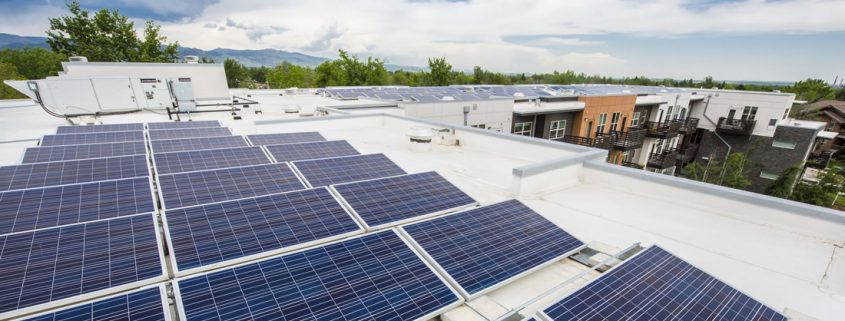Analysis Finds 5 Million Commercial Customers in the U.S. Could Cut Costs with Battery Storage
The U.S. Department of Energy’s National Renewable Energy Laboratory (NREL) and Clean Energy Group (CEG) have released the first comprehensive public analysis detailing the potential size of the commercial behind-the-meter battery storage market in the United States. NREL analyzed over 10,000 utility tariffs in 48 states, finding that more than five million of the 18 million commercial customers across the country may be able to cost-effectively reduce their utility bills with battery storage technologies.
These findings, grouped by utility service territory and state and illustrated in a series of maps and tables, are presented in NREL and CEG’s white paper, “Identifying Potential Markets for Behind-the-Meter Battery Energy Storage: A Survey of U.S. Demand Charges“.
The researchers looked at the number of commercial customers eligible for utility rate tariffs that included demand charges of $15 or more per kilowatt, an industry benchmark for identifying economic opportunities for behind-the-meter storage. They concluded that approximately five million customers were at or above this demand charge threshold, accounting for over 25 percent of commercial customers in the United States. This represents a substantial market opportunity for behind-the-meter battery storage, which can be installed to control peak demand and lower electricity bills by reducing demand charges.
The analysis determined that economic opportunities for storage exist not only in first-mover states like California and New York, but also across the Midwest, Mid-Atlantic, and Southeast. For example, tens of thousands of commercial customers in Georgia, Alabama, Kentucky, Michigan and Ohio may be subject to utility tariffs with sufficiently high demand charges to make storage a viable economic investment. Anticipated future declines in battery storage costs would enlarge the market potential in these and other states.
Seth Mullendore, coauthor of the paper and a project director at CEG, said:
“With this analysis, we have identified the areas where customers have the greatest potential to benefit from investments in battery storage. Utilities know where these opportunities exist, and now the rest of us have that information too.”
Nearly all medium to large commercial customers in every state are subject to utility demand charges, yet customers often do not understand how these charges are structured or accounted for. The charges affect private and nonprofit businesses, as well as a wide array of additional customers, including community facilities, public buildings, and multifamily housing properties. In many cases, these demand charges can comprise anywhere from 30 to 70 percent of a customer’s utility bill.
Joyce McLaren, lead author of the study and a senior energy analyst at NREL said:
“Declining costs for energy storage products have created opportunities for commercial customers to deploy batteries to manage peak demand and lower their electricity bills. However, prior to this analysis, no one had performed a comprehensive survey of where the high demand charges are across the country and how many customers might be paying them. Our research seeks to fill that information gap.”
Vic Shao CEO at Green Charge, said:
“Every day we speak to school districts, municipalities and other companies who face increasing costs in their utility bills. Traditional efficiency cost cutting measures including solar and LED lighting can only reduce a bill by so much. Energy storage directly addresses the demand charge problem so many organizations face. We hope the findings of this study shine a brighter spotlight on energy storage as an answer to lowering utility bills across the U.S.”
While this analysis represents a critical first step in identifying battery storage market opportunities, actual investment decisions will be dependent on individual building energy usage profiles and other detailed, customer-specific information. More work will be needed to determine how many customers are subscribed to these high demand charge utility tariffs and which of those customers use energy in a way that would allow storage to economically reduce demand. This on-the-ground work will require partnerships with local organizations and commercial customers interested in pursuing behind-the-meter storage solutions.
CEG President Lew Milford:
“This white paper offers a road map to the state-by-state development of economically driven, behind-the-meter storage markets over the next decade. Solar has proliferated in states with high volumetric utility rates in the last decade. Storage will follow a similar trajectory in states with high demand charges in the years ahead.”
Ted Ko, policy director at Stem, Inc. said:
“This report further validates the size and needs of a dynamic and growing market. Commercial and industrial demand charge savings are one of many important value streams that intelligent energy storage ‘as a service’ like Stem’s already optimize, and studies like these illustrate the potential for the service to dramatically scale in the U.S. to respond to customer needs while giving utilities a customer engagement service. Stem applauds the extensive work done here to provide a baseline “road map” for the growth of behind-the-meter storage to spur further dialogue and localized analysis.”
NREL and CEG will host a webinar on Tuesday, September 19th to discuss the findings of the report. Authors Joyce McLaren and Seth Mullendore will present their research and answer questions from the audience. For more information on this free webinar and to register, visit www.cleanegroup.org/webinar/NREL-demand-charges-storage-market.
This research is supported by the U.S. Department of Energy SunShot Initiative, a national effort to drive down the cost of solar electricity and support solar adoption. For more information about the research read below and visit Clean Energy Group’s website.
[embeddoc url=”http://www.cleanegroup.org/wp-content/uploads/NREL_BatteryStorage_2017.pdf” download=”all”]
Source: Press Release by Clean Energy Group. Image Credit: NERL via Flickr (CC BY-NC-ND 2.0).










